

Reaction times teacher notes. 'Plant factories' needed to grow more food as world population heads towards 10 billion by 2050 - ABC Rural - ABC News. Scientists are exploring taking crops out of the field and growing them in warehouses to develop new varieties capable of feeding 10 billion people by 2050.

Plant factories key points Key points: Indoor 'speed breeding facilities' are growing 1,000 plants per square metreResearchers are growing up to six generations of crops in a year instead of just two generationsThe technology has been used on crops including wheat, barley, chickpea, millet, sorghum and quinoa A review in the journal Nature Biotechnology has outlined efforts to harness technology like speed breeding, genome editing, growing crops indoors, and manipulating the temperature and atmosphere to fast-track new varieties of major crops like wheat and corn. Lead author Lee Hickey, a senior research fellow at the University of Queensland, said a suite of new technologies will increasingly be needed to feed the world as resources dwindle. Supplied: Queensland Alliance for Agriculture and Food Innovation Rural Newsletter. A Day in the Life of Your Heart. Stimulus/Response Lesson Plan.
Think Fast: Do Video Game Players Have Faster Reaction Times Than Non-Players? Effects of Exercise: Changes in Carbon Dioxide Output. Measuring Your Taste Threshold. Please ensure you have JavaScript enabled in your browser.
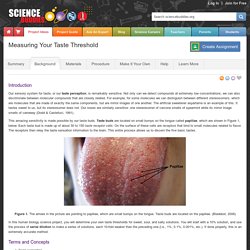
If you leave JavaScript disabled, you will only access a portion of the content we are providing. <a href="/help/javascript">Here's how. </a> Abstract Have you ever been to a buffet and found yourself surrounded by a wide variety of taste sensations? Objective To determine your threshold of taste for sweetness, sourness and saltiness. Share your story with Science Buddies! Yes,I Did This Project! Are Your Eyes Playing Tricks on You? Discover the Science Behind Afterimages! Smelly Science: A Sniff Test. Please ensure you have JavaScript enabled in your browser.
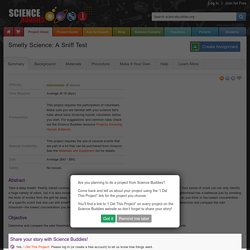
If you leave JavaScript disabled, you will only access a portion of the content we are providing. <a href="/help/javascript">Here's how. </a> Abstract. Weeds Be Gone! Experiment with Factors that Affect Roundup® Weed Killer. Please ensure you have JavaScript enabled in your browser.

If you leave JavaScript disabled, you will only access a portion of the content we are providing. <a href="/help/javascript">Here's how. </a> Abstract Farmers are constantly battling various types of weeds that compete with the crops they are trying to grow. Objective The objective of this plant biology science fair project is to determine how the dose and method of application affect the activity of a glyphosate-based weed killer, like Roundup®. Share your story with Science Buddies! Yes,I Did This Project! Credits David Whyte, PhD, Science Buddies. Here's One Simple Thing You Can Do When You're Totally Stressed Out. Here's What Happens to Your Body And Brain if You Stop Drinking Water. Stimulus Response.
How do we sense the flavors of food? In this minds-on, hands-on activity, students develop science practice skills by developing plans for a hands-on investigation, carrying out the investigation, analyzing the data, and interpreting the results.
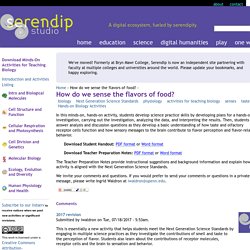
Then, students answer analysis and discussion questions as they develop a basic understanding of how taste and olfactory receptor cells function and how sensory messages to the brain contribute to flavor perception and flavor-related behavior. Download Student Handout: PDF format or Word formatDownload Teacher Preparation Notes: PDF format or Word format The Teacher Preparation Notes provide instructional suggestions and background information and explain how this activity is aligned with the Next Generation Science Standards.
We invite your comments and questions. If you would prefer to send your comments or questions in a private message, please write Ingrid Waldron at iwaldron@upenn.edu. Assessing skin sensitivity – temperature receptors. This procedure has been developed with the help of the Physiological Society.
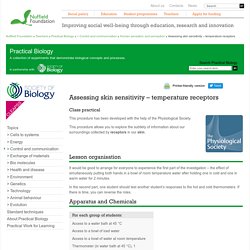
This procedure allows you to explore the subtlety of information about our surroundings collected by receptors in our skin. It would be good to arrange for everyone to experience the first part of the investigation – the effect of simultaneously putting both hands in a bowl of room temperature water after holding one in cold and one in warm water for 2 minutes. In the second part, one student should test another student’s responses to the hot and cold thermometers. If there is time, you can reverse the roles. Changes in earthworm responsiveness. An animal’s responsiveness to a particular stimulus can often show changes in the short term.
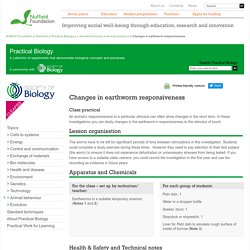
In these investigations you can study changes in the earthworm’s responsiveness to the stimulus of touch. The worms have to be left for significant periods of time between stimulations in this investigation. Students could complete a study exercise during these times. However they need to pay attention to their test subject (the worm) to ensure it does not experience dehydration or unnecessary stresses from being tested. If you have access to a suitable video camera, you could record the investigation in the first year and use the recording as evidence in future years. Petri dish, 1. Observing the effects of exercise on the human body. In this activity, your students are participating as subjects to provide data for analysis.
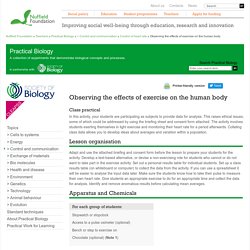
This raises ethical issues, some of which could be addressed by using the briefing sheet and consent form attached. The activity involves students exerting themselves in light exercise and monitoring their heart rate for a period afterwards. Collating class data allows you to develop ideas about averages and variation within a population. Adapt and use the attached briefing and consent form before the lesson to prepare your students for the activity. Develop a text-based alternative, or devise a non-exercising role for students who cannot or do not want to take part in the exercise activity.